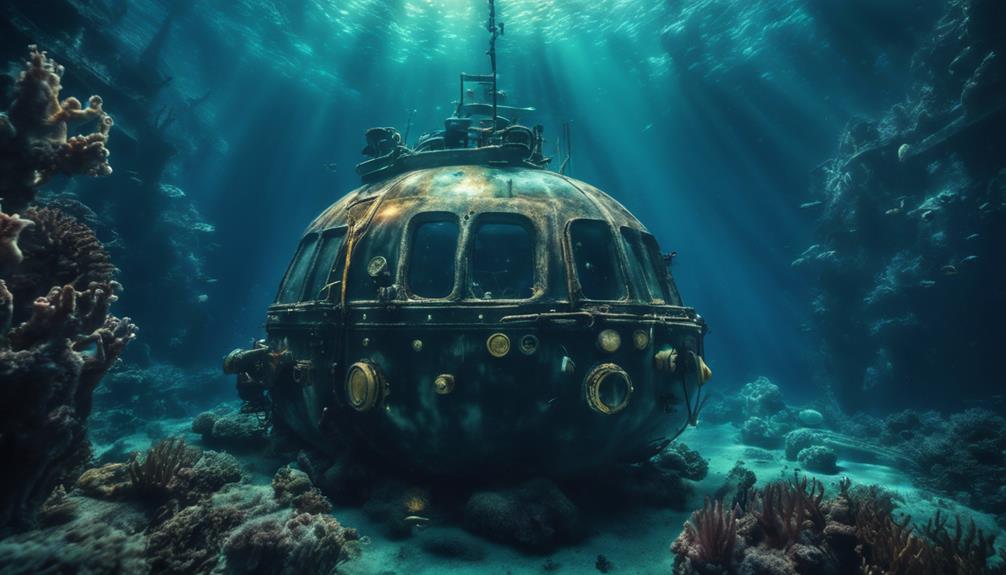Bob Ballard, an iconic ocean explorer, has made waves with his incredible feats. From discovering the Titanic to exploring WWII shipwrecks, he's transformed underwater archaeology. You'll appreciate his innovative technologies, like the ARGO/JASON system, which revolutionized deep-sea exploration. Ballard's commitment to education shines through his JASON Project, engaging millions of students in marine science. His work emphasizes the importance of preserving underwater cultural heritage and educating the public about marine conservation. As you discover more about his adventures, you'll uncover the rich history and mysteries that lie beneath the ocean's surface.
Background Information
Bob Ballard's journey as an explorer started in his childhood, fueled by a passion for submarines and marine life. As he grew older, he pursued his interests by studying oceanography and marine biology, eventually leading him to become a renowned oceanographer and explorer. Ballard’s insatiable curiosity and drive to push the boundaries of exploration have led him to discover and explore numerous undersea treasures. His work has not only revolutionized our understanding of the ocean, but also inspired others to follow in his footsteps, such as kim chambers incredible swimming accomplishments.
His groundbreaking work in deep-sea exploration has led to significant discoveries, including WWII shipwrecks and the Titanic.
You'll see how these experiences shaped his remarkable career and contributions to oceanography.
Submarine Enthusiast From Childhood
A fascination with marine life ignited in childhood, as the vibrant tidal pools of San Diego captured the imagination and laid the foundation for a lifelong passion for ocean exploration. Bob Ballard's early adventures in those tidal pools were further enhanced by the thrill of watching Disney's '20,000 Leagues Under the Sea.' This movie stoked his dreams of exploring the depths of the ocean.
At 19, you'd find Ballard working at North American Aviation, where he contributed to the development of the deep-ocean submersible ALVIN. His commitment to ocean exploration deepened during his service in the Navy during the Vietnam War, where he honed skills that would prove invaluable in his later career. After returning to Woods Hole Oceanographic Institution, Ballard fully embraced his destiny as an explorer.
To formalize his passion, he pursued education at the University of California, Santa Barbara, earning undergraduate degrees in chemistry and geology. He later achieved a Ph.D. in Marine Geology and Geophysics from the University of Rhode Island. This solid academic foundation helped propel him into the world of deep-sea exploration, making him a renowned figure in marine geology.
Deep-Sea Exploration Breakthroughs
Significant advancements in deep-sea exploration emerged from the innovative technologies and methodologies developed by Ballard and his team. You'll find that his work with robotic systems, such as the ARGO/JASON system and the ANGUS submersible camera, revolutionized how researchers study underwater environments. These technologies enabled you to explore previously unreachable depths, uncovering crucial information about hydrothermal vent ecosystems in the Galápagos Rift, which he discovered in 1977.
Ballard led the first successful underwater field mapping during Project Famous, laying the groundwork for modern ocean exploration. Over 160 deep-sea expeditions showcased his commitment to understanding the mysteries of the ocean. Using remotely operated vehicles, he documented shipwrecks, providing insights into their histories and the ecosystems surrounding them.
His exploration of the Titanic wreck in 1985 not only highlighted the tragic events surrounding the ship's sinking but also sparked a broader interest in underwater archaeology and marine conservation. Through these breakthroughs, you can see how Ballard's vision and technological advancements have paved the way for future deep-sea exploration, expanding our knowledge of the ocean's depths.
Exploration of WWII Shipwrecks
Throughout his career, Ballard has frequently explored WWII shipwrecks, uncovering essential historical insights and enhancing our understanding of naval warfare. His notable discoveries, like the German battleship Bismarck in 1989 and the USS Yorktown in 1998, showcase the advancements in underwater exploration techniques.
Utilizing remotely-operated vehicles (ROVs), you can see how Ballard meticulously documents these wrecks, revealing their conditions and the ecosystems surrounding them. These explorations highlight the importance of preservation, as WWII shipwrecks serve as underwater museums, offering invaluable resources for historical research and education.
They not only provide a glimpse into the past but also spark interest in underwater archaeology, a field that's gaining momentum thanks to Ballard's work. However, these discoveries also raise ethical implications regarding the exploration and potential salvage of these sites. You'll find debates about the balance between preserving history and the allure of recovering artifacts from the ocean floor.
Ultimately, Ballard's contributions to the exploration of WWII shipwrecks underscore both the excitement of discovery and the responsibility that comes with it, shaping how we view our naval history.
Current Updates or Main Focus
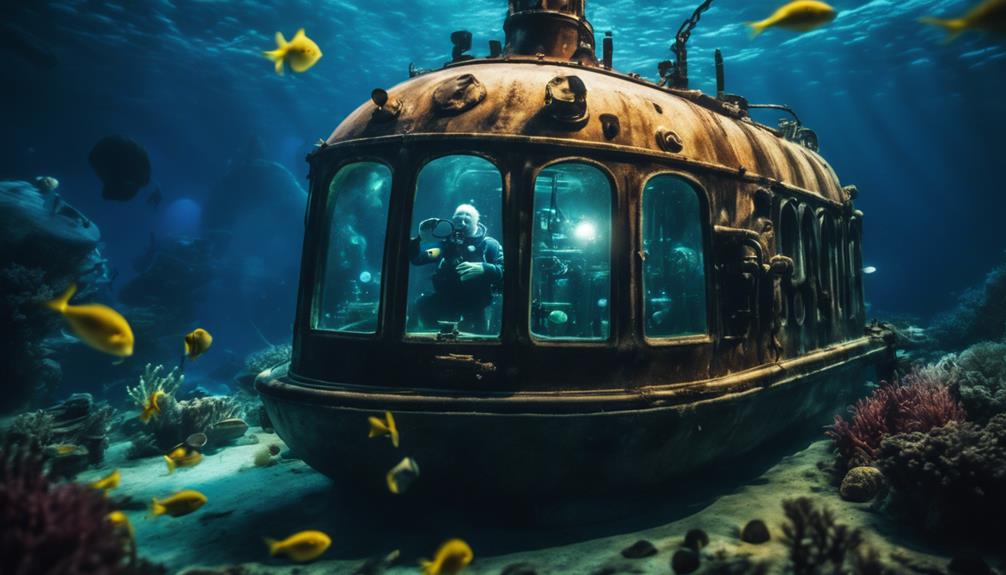
Bob Ballard's current focus includes groundbreaking underwater archaeology initiatives that aim to preserve historical shipwrecks.
You're likely to see how he's diversifying into educational outreach, inspiring the next generation of explorers.
Plus, keep an eye on his advancements in underwater robotics, which are revolutionizing deep-sea exploration.
Underwater Archaeology Initiatives
Dr. Ballard's current initiatives focus on creating underwater museums for historic shipwrecks, enabling virtual exploration and enhancing public understanding of maritime heritage. His groundbreaking work in underwater archaeology aims to preserve and showcase the stories behind famous wrecks like the Titanic and Britannic.
With the help of remotely-operated vehicles (ROVs), you can witness detailed documentation of these underwater sites, disclosing their historical significance. Ballard's exploration efforts have disclosed over 100 shipwrecks, showcasing the rich potential for learning about our maritime history.
A key player in this mission is the Nautilus, a ship equipped with advanced technology that supports ongoing research and exploration of the ocean floor. Moreover, his recent partnership with National Geographic takes things a step further by live-streaming expeditions, making underwater discoveries accessible to a global audience.
This initiative not only enhances public engagement in underwater archaeology but also promotes marine conservation, emphasizing the importance of protecting these valuable underwater sites. Through these efforts, you can immerse yourself in the past and appreciate the treasures hidden beneath the waves, all while supporting a greater cause.
Diversifying Into Educational Outreach
Building on the success of underwater archaeology initiatives, Ballard is now expanding his focus to educational outreach, aiming to inspire the next generation of explorers. Through the JASON Project, he's engaged over 1.7 million students in earth and marine sciences, making these subjects interactive and exciting. His presentations often include enthralling videos of his underwater explorations, sparking curiosity about ocean exploration among young learners.
During a recent visit to Hamilton School, Ballard shared his personal journey with dyslexia and ADHD, emphasizing the importance of embracing learning differences. By doing so, he encourages students to pursue their passions and think innovatively. He even recorded a podcast episode with 7th-graders, discussing academic challenges and exploration, thereby fostering a supportive environment for neurodiverse individuals.
Ballard's educational outreach not only promotes marine science but also encourages students to cultivate innovative thinking. By inspiring curiosity and providing relatable experiences, he's paving the way for future explorers to immerse themselves in the wonders of the ocean and beyond. You can see how his efforts are shaping a new generation, ready to tackle the mysteries of our planet.
Underwater Robotics Innovation
As the demand for advanced underwater exploration grows, innovations in robotics are becoming essential for uncovering the ocean's mysteries.
Bob Ballard has notably contributed to this field, developing groundbreaking submersible technology like ANGUS, a camera designed for extended exploration of the ocean floor. His time at Stanford University led to the creation of a remote-controlled photographic robot, specifically tailored for undersea exploration.
Ballard's refinement of the ARGO/JASON system, which employs remotely operated vehicles (ROVs), has revolutionized underwater archaeological research by allowing researchers to locate historically remarkable wrecks with precision. His expeditions have showcased the power of robotic systems, conducting over 120 undersea missions that highlight their capabilities in deep-sea exploration.
The Nautilus ship, named after Captain Nemo's vessel, embodies these advancements, equipped with cutting-edge technology for ongoing exploration. It even live streams discoveries, engaging the public and promoting scientific understanding of marine environments.
With these innovations, Ballard continues to push the boundaries of underwater exploration, demonstrating how robotics can reveal the secrets of the deep and enhance our appreciation for the ocean's vast, unexplored territories.
Detailed Analysis
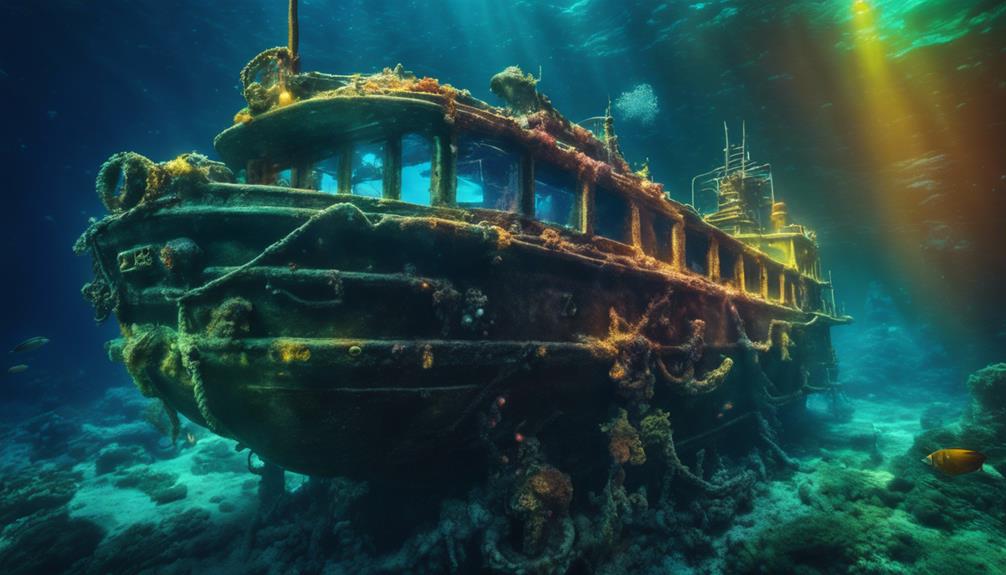
When you look at recent Titanic exploration efforts, you'll see how they build on Ballard's groundbreaking discovery.
The media frenzy around the Titanic's wreck has sparked renewed interest and highlighted the power of a well-structured plan in underwater exploration.
Understanding these elements not only underscores Ballard's impact but also reveals the ongoing significance of his work.
Recent Titanic Exploration Efforts
Recent explorations of the Titanic wreck have revealed stunning new footage and insights into its condition, sparking renewed interest in marine archaeology. In February 2023, Dr. Bob Ballard released rare footage captured by ROV Jason Jr. and HOV Alvin. This exploration showcased not only the wreck but also the surrounding deep-sea environment, highlighting the Titanic's stability amidst concerns of deterioration.
Ballard's innovative approach employs advanced technology, such as the ARGO/JASON system, to document significant shipwrecks, including the Titanic, Bismarck, and Lusitania. His ongoing efforts aim to locate and preserve these historical sites for future study. He envisions establishing underwater museums for the Titanic and Britannic, allowing for virtual exploration and enhancing public engagement with their stories.
With an estimated three million shipwrecks still unaccounted for, Ballard's work emphasizes the potential for further marine archaeological research. The future looks promising, especially with the upcoming addition of the USNS Robert Ballard (T-AGS 67) to support these exploration efforts. As you follow these developments, you'll appreciate the crucial role technology plays in uncovering our maritime history.
Titanic Discovery's Media Frenzy
Bob Ballard's groundbreaking discovery of the Titanic wreck not only reignited public fascination with the maritime disaster but also triggered a media frenzy that continues to influence underwater exploration narratives today.
When Ballard located the Titanic at a staggering depth of 13,000 feet, the media jumped on the story, enthusiastic to share the latest in underwater exploration technology. The use of advanced tools like the remotely operated vehicle Jason Jr. and the manned submersible ALVIN allowed for unprecedented footage of the shipwreck and its surrounding deep-sea ecosystems.
Collaborations with National Geographic further amplified the media's excitement, showcasing findings and ongoing research related to the Titanic. This partnership produced compelling exhibits that drew large crowds, eager to learn about the famous ship and its tragic fate.
As Ballard's work gained attention, it sparked significant public discourse about the ethical considerations of exploring shipwrecks. People began to debate the ownership and preservation of sites like the Titanic, questioning how best to honor the lives lost.
The media frenzy didn't just celebrate a discovery; it opened up crucial conversations about the responsibilities that come with underwater exploration.
Power of a Well-Structured Plan
A well-structured plan was essential to Dr. Bob Ballard's success in uncovering the Titanic, demonstrating how strategic approaches can lead to groundbreaking discoveries in underwater exploration.
Ballard's meticulous planning included the use of advanced exploration technology and submersibles like ALVIN and ROV Jason Jr., which were significant for maneuvering the depths of the ocean. His systematic approach was highlighted through Project Famous, where he laid the groundwork for detailed underwater field mapping, paving the way for future expeditions.
Ballard secured critical funding and support from influential figures, such as Navy Secretary John Lehman, enabling the development of innovative exploration tools necessary for his deep-sea missions. Over seven years, he meticulously documented more than 120 undersea expeditions, refining his methods to locate historically significant wrecks. This showcases the importance of structured planning in achieving exploration goals.
Furthermore, the establishment of the JASON Project exemplifies Ballard's dedication to education and outreach. His effective planning not only led to incredible discoveries but also inspired future generations to explore ocean sciences, fostering a greater understanding of our underwater world.
Public Reaction or Expert Opinions
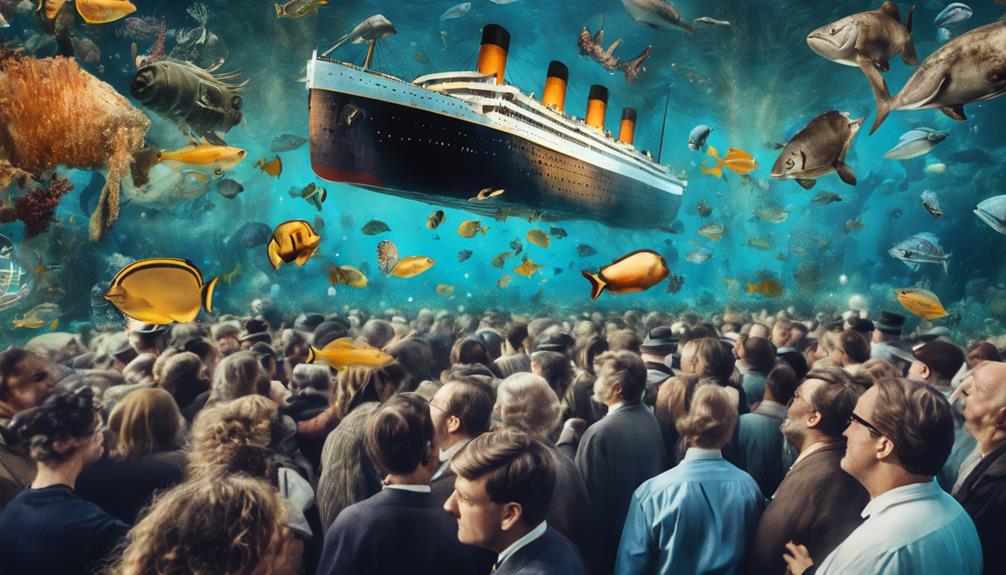
You might notice how social media reflects the excitement surrounding Bob Ballard's discoveries, with trending topics sparking discussions among enthusiasts and experts alike.
Audience engagement has surged, showing a deep-seated interest in marine exploration and history.
Marine archaeologists also share their insights, shedding light on the significance of Ballard's work and its impact on the field.
Twitter Trends and Reactions
In recent days, conversations on Twitter have exploded with enthusiasm for Dr. Bob Ballard's groundbreaking ocean exploration work, particularly his contributions to the Titanic and hydrothermal vents. Users are sharing insights and expressing gratitude for Ballard's innovative technology, like the ARGO/JASON system, which has set new standards in underwater exploration. This surge in interest reflects a renewed fascination not just with the Titanic, but also with the broader field of ocean exploration.
Experts in marine science have chimed in, praising Ballard's efforts in raising awareness about marine conservation and the importance of preserving historical sites.
As you scroll through your feed, you'll notice discussions around the significance of embracing neurodiversity in STEM fields, sparked by Ballard's own experiences with dyslexia and ADHD. This has resonated deeply with educators and advocates, prompting trending conversations about the value of diverse learning styles in pioneering fields like oceanography.
Additionally, excitement is building around upcoming publications and documentaries about Ballard's life, with many anticipating how these projects will inspire future generations of explorers.
It's clear that Dr. Ballard's work continues to ignite passion and curiosity in the public sphere.
Audience Enthusiasm and Engagement
Audience enthusiasm for Dr. Bob Ballard's explorations has surged, with many expressing admiration for his ability to inspire curiosity and passion for marine sciences. His discovery of the Titanic in 1985 captivated global audiences, igniting a widespread interest in ocean exploration and marine archaeology.
When Ballard visited Hamilton School, he actively engaged with 6th-graders, demonstrating how his presentations and videos of underwater journeys can spark excitement in students.
Ballard's personal journey with dyslexia and ADHD resonates deeply with many, reinforcing the message that challenges can be overcome. This encouragement has motivated countless students to pursue their passions, regardless of academic hurdles.
Through the JASON Project, Ballard has reached over 11 million children, sparking enthusiasm for earth and marine sciences through innovative educational programs.
Public interest in his expeditions remains strong, thanks to numerous documentaries and his upcoming memoir, *Into the Deep*. This sustained engagement not only solidifies Ballard's legacy but also fosters a new generation of explorers and scientists keen to plunge into the mysteries of the ocean.
Insights From Marine Archaeologists
Many marine archaeologists view Bob Ballard's discovery of the Titanic as a groundbreaking event that transformed how the public perceives underwater exploration and cultural preservation. His use of technological innovations, like the ARGO/JASON system, has greatly enhanced our ability to locate and document shipwrecks. These advancements not only made the Titanic accessible but also sparked a broader interest in marine conservation and historical preservation.
However, public reaction to Ballard's discoveries varies. While many are fascinated, some raise ethical concerns about treating sites like the Titanic as tourist attractions rather than sacred graves. This debate highlights the delicate balance between exploration and preservation that marine archaeologists grapple with daily.
Ballard's JASON Project has furthered this mission, engaging over 1.7 million students and inspiring the next generation of ocean explorers. His advocacy resonates deeply with marine archaeologists, who emphasize the importance of protecting underwater cultural heritage from exploitation and degradation.
Broader Implications
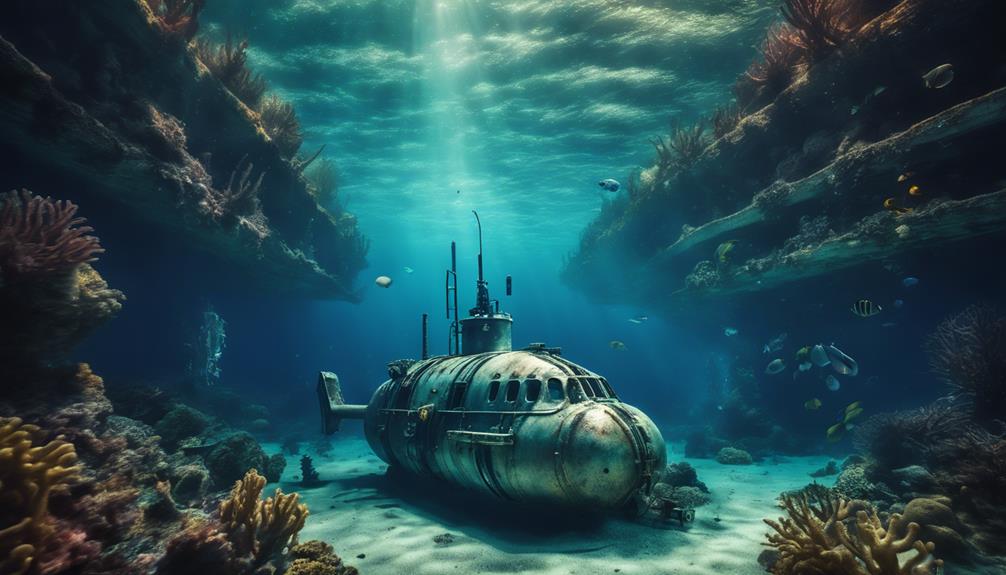
Bob Ballard's work has transformed how you view underwater exploration technology and its role in conservation.
His initiatives not only enhance educational opportunities but also inspire a new generation to protect our ocean's heritage.
As you explore these implications, consider how they impact both science and society.
Advancing Underwater Exploration Technology
Advancements in underwater exploration technology, like the development of submersibles and robotic systems, have transformed how we study and understand the ocean's depths. With tools like Bob Ballard's ANGUS, a submersible camera, researchers can conduct extended explorations of the ocean floor, leading to detailed observations of underwater ecosystems. His work on the ARGO/JASON system has revolutionized how we locate and document historically significant wrecks, including the Bismarck and Lusitania, during over 150 deep-sea expeditions.
The shift from human-operated dives to robotic systems, particularly during explorations like the Titanic, marks a major milestone in exploration technology. These advancements allow for safer and more precise investigations, minimizing risks to human life. Additionally, the Nautilus ship, equipped with advanced submarine technology, showcases the potential of live-streamed expeditions, engaging the public in real-time and making the mysteries of the ocean accessible to a global audience.
As you explore the implications of these technologies, you'll see how they not only enhance our understanding of marine environments but also inspire future generations to continue unraveling the secrets of the deep sea.
Oceanic Conservation Initiatives
Technological breakthroughs in underwater exploration have revealed the intricate relationships within marine ecosystems, underscoring the urgent need for oceanic conservation initiatives. Bob Ballard's work, particularly his discoveries around hydrothermal vents, highlights the significance of protecting oceanic biodiversity. By showcasing unique deep-sea environments, he emphasizes that we must act to conserve these fragile ecosystems.
Through educational projects like the JASON Project, Ballard has inspired over 11 million children to engage with marine science and conservation. This education is essential, as it fosters a new generation of advocates dedicated to preserving our oceanic heritage. Initiatives such as underwater museums for shipwrecks, including the Titanic, serve to promote awareness and heritage while minimizing impact on delicate marine environments.
Ballard's ongoing advocacy stresses that technological advancements are critical for understanding and protecting ocean ecosystems from human activities and climate change. With the USNS Robert Ballard symbolizing a commitment to exploration and conservation, you're encouraged to support marine preservation efforts.
Transforming Education Through Exploration
Transforming education through exploration ignites curiosity and empowers students to engage actively with the sciences. Dr. Bob Ballard's JASON Project embodies this approach, having connected over 1.7 million students to earth and marine sciences through hands-on learning. His real-world expeditions, like the discovery of the Titanic, serve as powerful educational tools, inspiring students to explore careers in STEM fields.
Ballard emphasizes teamwork and problem-solving, vital skills for scientific exploration. By working together on projects, students learn to navigate challenges and think critically, essential for any future endeavors in science. His advocacy for embracing learning differences, drawing from his own experiences with dyslexia and ADHD, encourages students to cultivate resilience and passion.
Furthermore, the live streaming of expeditions by the Nautilus Exploration Program brings marine exploration into classrooms, allowing students to witness discovery in real-time. This connection between education and exploration not only enhances learning but also fosters a sense of wonder about the natural world.
Frequently Asked Questions
What Did Robert Ballard Accomplish?
You'll find that Robert Ballard accomplished remarkable feats in underwater exploration, including discovering the Titanic, pioneering advanced submersible technology, and fostering marine science education through initiatives that engaged millions of students in ocean exploration.
What Are Some Cool Facts About Robert Ballard?
You'll find Robert Ballard's achievements fascinating! He discovered the Titanic wreck, explored hydrothermal vents, led over 160 deep-sea expeditions, and founded the JASON Project, inspiring millions in marine science. A true ocean pioneer!
How Many Shipwrecks Did Robert Ballard Discover?
You'll find that Robert Ballard discovered over 100 shipwrecks during his career. His explorations have unearthed significant wrecks, enhancing our understanding of maritime history while showcasing his remarkable skills and innovative technology.
Did Robert Ballard Find Amelia Earhart's Plane?
You won't find Amelia Earhart's plane among the discoveries from the 2019 expedition. While Robert Ballard's team explored Nikumaroro, they uncovered various artifacts, but no definitive evidence of her aircraft was located.
Conclusion
To sum up, Bob Ballard's incredible achievements inspire awe and curiosity in all of us.
His relentless pursuit of discovery not only expands our understanding of the ocean's mysteries but also highlights the importance of exploration in our world.
As you reflect on his journey, consider how his work encourages you to embrace your own adventures and seek knowledge beyond the familiar.
The ocean's depths hold countless secrets, and who knows what you might uncover if you dare to explore?

